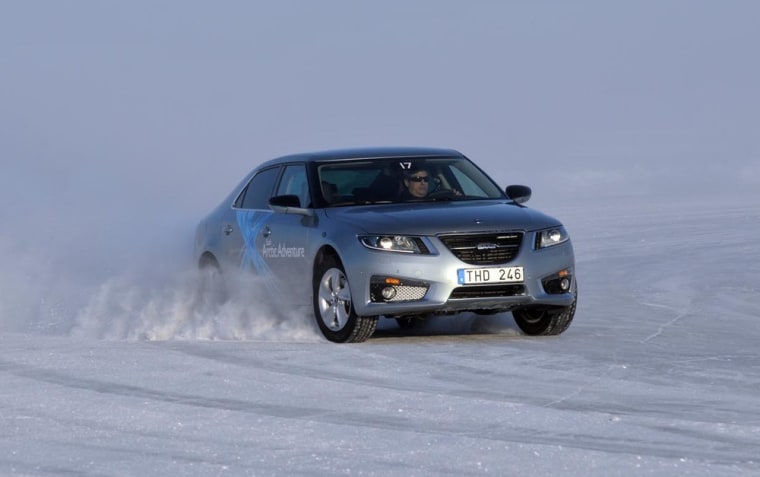A bitter wind blows across the frozen lake, the mercury dipping to a finger, toe and mind-numbing 40 degrees below zero. But the members of the Saab Performance Team barely notice as they put the Swedish carmaker’s latest offerings through their paces.
The days are short, here 125 miles above the Arctic Circle, so everyone works quickly. It helps them ignore the cold. Like many automakers, Saab uses the vast and frozen Swedish north to winter test its future products, although this particular morning the team has welcomed a handful of visitors that has come to see how products like the new 9-3 SportCombi wagon can handle temperatures cold enough to turn antifreeze into slush.
It’s a challenge Saab President Jan Ake Jonsson knows is critical to rebuilding the reputation of a brand that has all but dropped off the radar for the typical car buyer. In fact, just one year ago the Saab brand nearly vanished entirely.
Based in Trollhattan, Sweden, Saab was one of four nameplates that General Motors agreed to abandon as part of its emergence from bankruptcy in 2009, along with domestic brands Pontiac, Saturn and Hummer. Even as potential buyers tried to negotiate a deal, GM began to wind down Saab’s operations, dismissing its board and shuttering its sprawling assembly plant.
With the assistance of a loan from the European Investment Bank, the Dutch-based supercar maker Spyker emerged, at the 11th hour, as Saab’s white knight. But it still took nearly two months, once the fragile deal was completed, to ramp operations back up, leaving Saab dealers around the world struggling for product to sell for most of last year.
Global sales more than doubled during the final quarter, but still totaled just 31,696 for all of 2010. Sluggish demand in the critical U.S. market led Saab to dismiss American chief executive Mike Colleran just after the new year.
Nonetheless, Saab’s Jonsson insists he’s not worried, describing the period from 2010 to 2012 as “our build-up years.”
Saab fans — of which there are still many — were doubly disappointed by the carmaker’s near collapse because it occurred just as the company was ready to roll out an all-new version of its flagship 9-5 sedan, after more than a dozen years waiting.
Saab is also putting the final touches on the new 9-4X, the maker’s first crossover, which went into production earlier this month. It replaces the much-maligned 9-7X — a thinly-disguised GMC sport-ute that never lived up to sales expectations.
On the frozen lake in Sweden, in Kiruna, the performance team showed off Saab’s new cross-wheel-drive, or XWD, system. The new alternative to classic all-wheel-drive — which will be offered on the 9-4X, as well as the 9-3 SportCombi and 9-5 — not only shifts power from front to back, depending on where torque is needed, but also from left to right. That helps power a car through a corner, and it underscores Saab’s sporty ambitions.
But the critical piece in the Saab comeback puzzle is still more than a year away — a replacement for the brand’s top-seller, the midsize 9-3, that could help to push Saab back into the black. Hefty cost-cutting — and a well-negotiated sales agreement — mean the company could make money on sales of as little as 85,000 units a year, according to Victor Muller, the founder of Spyker and chairman of the combined Saab-Spyker.
To keep costs down, the company has also been working up plans to partner with more established manufacturers, such as BMW. The German carmaker has agreed to provide Saab with powertrains for future models. A similar strategy could help Saab pull together plans for a rumored 9-2, a downsized sports sedan that would be pitted against competitors like the BMW 3-Series and Audi’s A4.
Saab’s plan is “do-able,” suggested Aaron Bragman, an automotive analyst with the consulting firm IHS, but there are plenty of skeptics.
Indeed, even Saab officials admit their first challenge is to simply build consumer awareness — no easy task in such a crowded and competitive market.
But despite calling the job of rebuilding Saab “a self-inflicted hell,” Muller, a successful Dutch entrepreneur,” contends that there is a niche for the Swedish brand, which has always appealed to those who don’t want to buy a “me-too” luxury car.
The company’s budget is tight, with far less money available for conventional marketing than its more mainstream competitors. Saab did invest in a fairly costly TV campaign designed to tell buyers it’s back, but it’s now taking a viral approach to marketing, trying to reach the sort of non-traditional customers who get its pitch.
Instead of occupying a spot on the floor of the Cobo Center during the Detroit auto show last January, something that could have cost the company several million dollars, Saab instead set up the “Saab Ice House” on the grounds of an abandoned hotel right across the street.
It was a fitting showcase for a Swedish brand, but eventually, Saab — and its performance team — has to come in out of the cold. And new models like the 9-4X and 9-3 SportsCombi won’t have much time to heat up the market.
